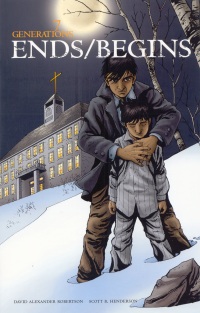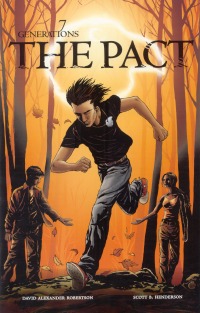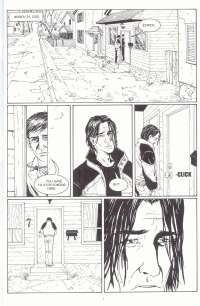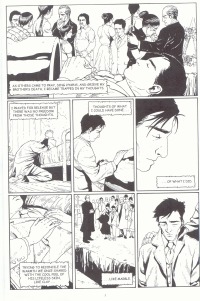| ________________
CM . . . . Volume XVIII Number 10 . . . . November 4, 2011
Ends/Begins and The Pact continue and conclude the four-part graphic novel series entitled "7 Generations". As in the previous two volumes, Stones and Scars, David Alexander Robertson combines past and present events in the history of one Aboriginal family, extending over seven generations. And, as with Stones and Scars, the final two books of the series each begin by providing a segue from the previous book before continuing with the dominant story for that volume.
When James finally attacks the priest who has abused Thomas, he is gripped by a furious (and justifiable) rage and beats the man brutally. But, it is too late to save Thomas who has run away from the school into the cold winter's night. Then, the story flashes forward 30 years to 1994, and readers see Edwin as a little boy, playing in the street in front of his home. A car thunders down the street, and James grabs the child just in time to save him, but then, he rips the belt from his trousers, wields it threateningly over his son, and that's where Book 3 ends.
Then, the story of James and Edwin, the focal story of The Pact, resumes at the point where Book 3 ended. Lauren, Edwin's mother, walks in the door of their family home and intervenes, preventing James from beating his son with his belt. James realizes how close he has come to seriously injuring Edwin, and while Lauren understands that her husband is wrestling with personal demons, she knows that there is only one solution to the situation: James has to leave and heal himself. Of course, all that Edwin remembers from that day are his feelings of abandonment and the subsequent experience of growing up without a father in his life. James does feel terrible remorse, first for failing his brother, and then, his son. As a young man, James' inability to find personal peace after his brother's death leads to a break-up with his then-girlfriend, Lauren. She is a strong woman: she went to the city, got an education, and did well for herself, "with a good job and a nice house, where you're living right now." (16) However, though, she remains in love with James, (who is at a very low point in his life, alcoholic and without purpose or direction), and they re-establish their relationship. In 1991, Edwin is born, and, with his son's birth, James experiences hope for the first time in years. It is now 2010, and despite having heard his father's story, Edwin remains angry and, like his father, unwilling to let go of the pain of the past. But, the two men make an attempt to heal the breach that keeps each from being the parent or child that the other needs. They head out into the countryside and, by the side of a river, find a "place where that healing can begin for both". (28) Edwin then takes off the amulet that Lauren gave him when he was recovering from his suicide attempt in Stone (Book 1), and, as he gives it to James, forgives his father, before leaving to continue his journey, on his own. They have made a pact. Thus, the four books of the "7 Generations" series come full circle, and the final page of The Pact ends with a visual montage of characters from all four books, underscoring the connections amongst the seven generations. Both Ends/Begins and The Pact are emotionally powerful works, and Scott Henderson's black and white visuals add to the impact of Robertson's narratives, particularly in the depiction of the residential school experience. Furthermore, the generational impact of its aftermath – the loss of culture and language, inter-generational family dysfunction, and coping with emotional pain through self-destructive behaviours – are clearly evident in both the telling and the illustration of the stories. It takes some skill as a reader to follow these converging story lines and to pick up on the references to the characters and events of Stones and Scars. Because of these connections with the previous books, it is really best that the four books of the series be read in sequence. Whether as part of a high school library collection, or as material for native studies content in high school English classes, Ends/Begins and The Pact are best for high school audiences, starting at the Grade 10 level. Recommended. Joanne Peters, a retired high school teacher-librarian, lives in Winnipeg, MB.
To comment
on this title or this review, send mail to cm@umanitoba.ca.
Copyright © the Manitoba Library Association. Reproduction for personal
use is permitted only if this copyright notice is maintained. Any
other reproduction is prohibited without permission.
NEXT REVIEW |
TABLE OF CONTENTS FOR THIS ISSUE
- November 4, 2011.
AUTHORS |
TITLES |
MEDIA REVIEWS |
PROFILES |
BACK ISSUES |
SEARCH |
CMARCHIVE |
HOME |


 The "back story" of Ends/Begins commences in March 24, 2010, with Edwin standing at the door of his father's home, once again attempting to re-establish a connection with the man who left the family, sixteen years ago. But, as with previous meetings, this one ends in disappointment and anger. Then, the clock turns back to 1964, and the focal story begins, with Edwin's father, James, and his uncle, Thomas, leaving their family home to attend a residential school run by Roman Catholic clergy. Once at the school, the boys' hair is cut, they are forbidden to speak their own language, are given "new" clothing, and "pretty soon [they] looked like whites. Except, you know, for the brown they couldn't scrub away." (10) Forced to pray in Latin, fed sub-standard food, and, in Edwin's case, made to work on the grounds of the school-yard, it is a sad and lonely life for both. However, it is even worse for Thomas who is victimized, shamed, and humiliated.
The "back story" of Ends/Begins commences in March 24, 2010, with Edwin standing at the door of his father's home, once again attempting to re-establish a connection with the man who left the family, sixteen years ago. But, as with previous meetings, this one ends in disappointment and anger. Then, the clock turns back to 1964, and the focal story begins, with Edwin's father, James, and his uncle, Thomas, leaving their family home to attend a residential school run by Roman Catholic clergy. Once at the school, the boys' hair is cut, they are forbidden to speak their own language, are given "new" clothing, and "pretty soon [they] looked like whites. Except, you know, for the brown they couldn't scrub away." (10) Forced to pray in Latin, fed sub-standard food, and, in Edwin's case, made to work on the grounds of the school-yard, it is a sad and lonely life for both. However, it is even worse for Thomas who is victimized, shamed, and humiliated.
 Book 4, The Pact, begins by concluding the episode in which James finds Thomas and takes him home. Fleeing the residential school, barefoot and clad only in his pyjamas, Thomas trips on a rock, strikes his head, and bleeds to death. James is devastated by his brother's death and consumed with guilt: "I prayed for release but there was no freedom from those thoughts . . . .Thoughts of what I could have done . . . of what I did." (3)
Book 4, The Pact, begins by concluding the episode in which James finds Thomas and takes him home. Fleeing the residential school, barefoot and clad only in his pyjamas, Thomas trips on a rock, strikes his head, and bleeds to death. James is devastated by his brother's death and consumed with guilt: "I prayed for release but there was no freedom from those thoughts . . . .Thoughts of what I could have done . . . of what I did." (3)